#do they count as animals colloquially if they're hominidae? who cares! gnarly bones!
Explore tagged Tumblr posts
Note
Tell me about the anatomical traits of bipedalism this is not a joke I really want to know
REEEHEEHEE lucky me!! this is gonna focus on (the rise of) human bipedalism (pun intended) because i dont know jackshit about any other animals! ALSO im going to link everything i mention to its wikipedia article as further reading 4 those interested :3
also, pleas keep in mind i have zero formal education on this whatsoever i am literally just a hyperfixated child
Before we get straight into it, a brief word on evolution, since I include some human ancestors here- if you see a scientific name rather than a colloquial one like chimp or gorilla, that's a human ancestor. The reason the ancestors in question look like they're transitioning from chimps to humans is because chimps and the rest of the great apes haven't begun their bipedalism journey, and human ancestors did! We're more derived than chimps from our common ancestor :3 that's all thank you
The skull // foramen magnum positioning
OK SO i have no idea how to ease into this so im throwing it all at you raw. This is a human skull from the bottom view with the jaw removed:
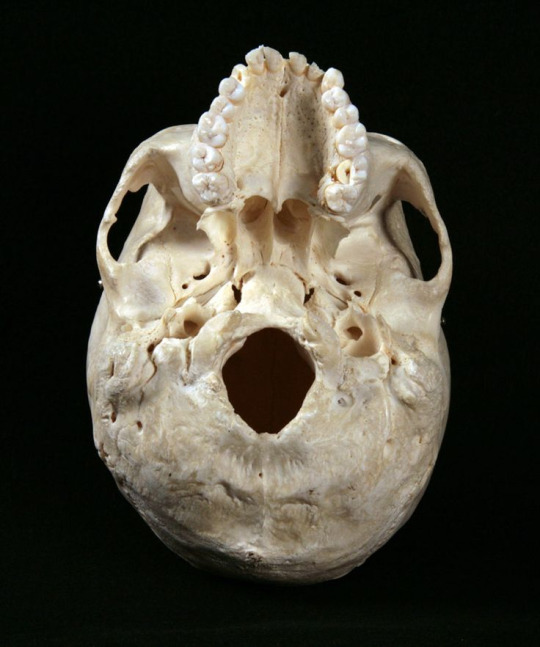
Aside from looking freaky as hell, it's also got that big hole right in the center. It's called the foramen magnum, and it's the hole where your brain connects to the spinal cord- AKA, where your neck is. Cool, but what's this gotta do with anything? Take a gander now at this gorilla skull:
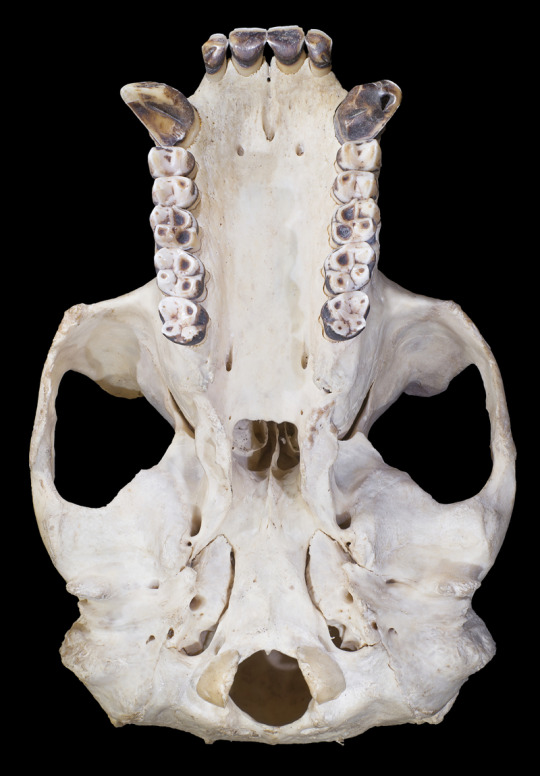
(Image src: https://commons.wikimedia.org/wiki/File:Gorilla_Male_skull_base.png)
See how much closer to the back of the skull the gorilla's foramen magnum is? This is because gorillas primarily walk quadrupedally!
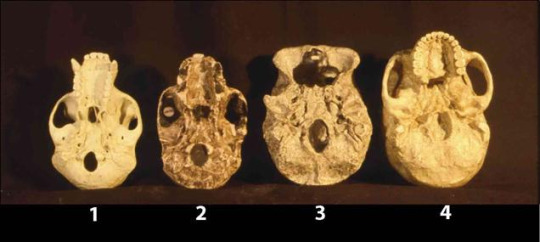
(Image src: https://origins.swau.edu/papers/man/hominid/index.html)
Here's also an example of the changing of its placement as bipedalism evolved- from left to right, that's a modern chimpanzee, Australopithecus africanus, Homo erectus, and a modern human.
If you're having trouble imagining how the placement of the neck could indicate how a primate walks, try getting on all fours and looking around you- you have to tilt your head up almost as far as it can go just to see forwards, and you can't see directly above you like you can when standing on your legs. If you try to maintain the position for a while, you'll get exhausted- and a majority of the mobility in your neck is now useless, because who cares about seeing the floor from twenty different angles? All of this is taken care of by just making the neck come out a lil closer to the back of your head. Behold my incredible artistic explanation:
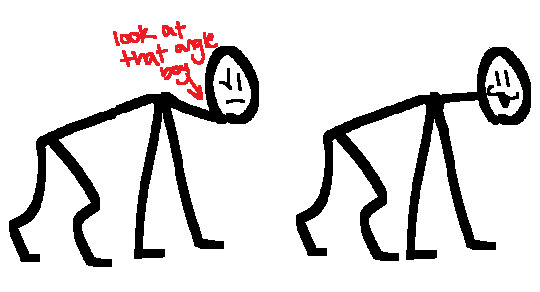
The placement of the neck is uh, a LITTLE exaggerated, but you get the gist. Or at least, I hope you do, 'cause I'm moving on now.
The curves // spinal structure
Ok I'm going to come clean about this i think the spine is the most boring aspect of primate bipedalism to talk about because it's biophysics and its like whats the point of biology if you're just going to make it physics again, I came here to escape! But FINE, I'll talk about it.
also my sources here are probably the least reliable in the whole post because i had to go refresh my memory on fucking QUORA because i completely zone out whenever someone starts talking biophysics. SORRY FOR RAMBLING FOR TWO ENTIRE PARAGRAPHS it will happen again
Behold the curves in the spine for this chimp vs. this Man.

(Image src: https://www.quora.com/Why-do-human-spines-zig-zag-unlike-other-apes-How-is-it-not-detrimental)
And you should immediately see the differences. I mean, the red line's right there for you. C'mon. That dip inwards at the neck is called the cervical curve, the bump outwards at your ribcage is your thoracic curve, the final dip inwards between the ribs and the pelvis is the lumbar curve, and the tailbone-ish bit at the pelvis is your sacral curve! And quadrupedal apes have none of it.
The reason, in short, is gravity. It's painfully difficult to find an image that shows this that doesn't look goofy as hell, so please have this hilariously crunchy picture because it's the best I can do short of making my own.

(Image src: https://efossils.org/book/lumbar-vertebra)
This is where we get to the physics bit that I'm really not confident about whatsoever and I could be completely making up but AS FAR AS I UNDERSTAND:
Essentially, the weight on either side of that line has to be somewhat equal, but the dot it comes out of cannot move. Whenever a chimp like in the images or something similar stands up, it has to exert constant muscular effort to remain upright, because there's an imbalance. There isn't a demonstration of this I can think of like we had for the foramen magnum, but just imagine doing that Michael Jackson lean stunt or being bent over at your hip constantly. Physics bit over.
So, to keep us from being Anatomically Hunched Over Forever, we developed the lumbar curve- but because just inverting the curve in our spine was basically just as bad because now our ribs would be weird, we also got the thoracic curve to make up for it- but because our head being bent forward with the thoracic curve would also be weird (it'd create the same issue as discussed above with the foramen magnum), we ALSO got the cervical curve to make up for that. Do you see now why I don't like this? Funny as hell, don't get me wrong, but man.
The ass // pelvic structure
Can you tell my maturity is rapidly declining? The pelvis, as you can probably guess, is really indicitave of whether a primate was bi or quadrupedal. Feast your eyes upon the pelvis bones of a chimp, an Ardipithecus ramidus, and a human respectively.
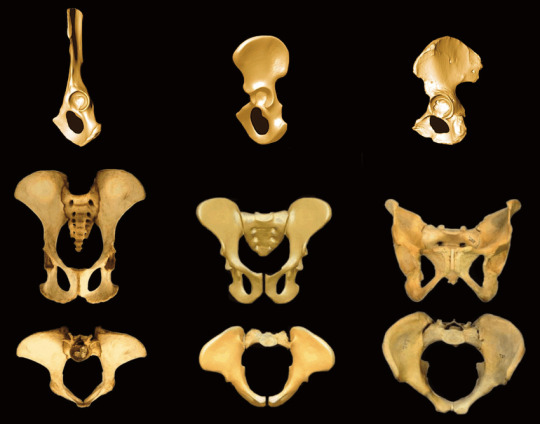
(Image src: https://www.researchgate.net/figure/The-Ardipithecus-pelvis-at-44-mya-was-already-more-human-than-chimpanzee-like-Three_fig4_280721011)
Take a look at that side view in the first row- it's wild how different those shapes are! If you're having trouble picturing this in 3D, a human pelvis is more bowl-shaped whereas a chimp's is kind of flat, like a road sign. This allows for two main things, as far as I can tell - one, our pelvises literally serve as bowls for our internal organs, just as extra support, and two, this broader, wider area gives more space for the ass muscles to attach, which makes standing on one leg easier- a problem quadrupeds obviously don't have.
A second change you might notice is that the pelvis obviously shrunk along with changing shape! This is to bring the sacral curve closer to the hips to create sort of a ⊥ (upside-down T) shape, which makes everything way more stable than if it was a ⅄ (upside-down Y) shape. This matters because the ball-and-socket joints we walk on are actually relatively unstable to balance on, we needa make things as stable as possible, to put less muscular effort into balancing!
Another, far, faar more subtle difference is the size of the hip joints (check the side views in the first row again - not the holes! The little circular imprints above them) has gotten bigger! This is because when you half the number of limbs that are supporting your weight, you double the weight each limb is carrying- so our bones need to be thicker and stronger than a quadrupedal ape's down there!
The legs // knee structure
I'm not doing this. No more physics please no more physics
The feef // inline big toes and arches
Let's kick (lol. lmao) this bit off with some human-chimp comparisons, as always!
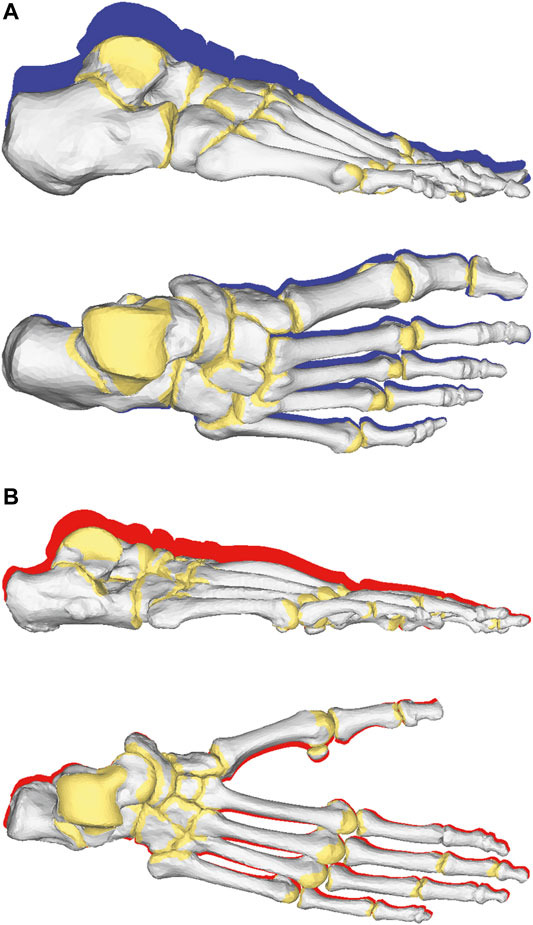
The big thing here, as you can guess, is the weird big toe chimps have (although we gotta keep in mind that we're the more divergent species, AKA the weird ones!) which you probably already know is for climbing trees! As our ancestors left the canopies we slowly lost need for a big toe like that and now we've got lame ass feet.
One thing we did gain, though, is three arches in our feet- y'know, that inwards dip in the "palm"? Chimps and other quadrupedal apes don't have that, and are flat-footed! It helps with walking and stuff. I dunno.

God, that's a lot! If you read all the way here, um, thank you! Hope you learned something or at least thought this was cool ^^ I'd be happy to try and answer any questions :3!!
#cw animal bones#tw animal bones#animal bones tw#animal bones cw#do they count as animals colloquially if they're hominidae? who cares! gnarly bones!#bones tw#bones cw#cw bones#tw bones#skull tw#tw skull#skull cw#cw skull#no id#no description#[IF SOMEONE WOULD BE WILLING TO WRITE IMAGE DESCRIPTIONS FOR ALL OF THESE I WOULD LOVE YOU FOREVER AND EDIT THEM ONTO THE POST !!! TY]#🐞 || asks#🐞 || beetle's bad biology
22 notes
·
View notes